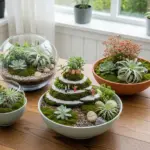7. Pest Infestations You Might Be Missing

I thought my rosemary was just having an off week when the leaves started looking a little dull and lifeless. Little did I know, there was an entire microscopic army living on my plant, slowly sucking the life out of it one tiny bite at a time.
It wasn’t until I accidentally knocked the plant over and saw dozens of tiny white specks flying around that I realized I had a serious pest problem on my hands.
Common Rosemary Pests That Love to Hide
Spider mites are the sneakiest little devils you’ll ever deal with. They’re so tiny you can barely see them without a magnifying glass, but the damage they cause is unmistakable – fine webbing between leaves and that dusty, stippled appearance on the foliage.
I missed them for weeks because I was looking for big, obvious bugs. These guys are practically invisible until their population explodes.
Aphids on rosemary tend to be green or black, and they love clustering on new growth tips. They’re like tiny vampires, sucking plant juices and leaving behind sticky honeydew that attracts other problems.
Whiteflies are what I discovered when I knocked over my plant. They look like tiny white moths and fly up in clouds when you disturb the plant. Super annoying and surprisingly hard to get rid of.
Scale insects look like little brown bumps stuck to stems and leaves. I actually thought they were part of the plant at first – they’re that good at camouflaging themselves.
Early Detection Techniques Using Your Smartphone
This is where technology became my best gardening tool. Smartphone flashlight detection changed everything for me once I learned the tricks.
Shine your phone’s flashlight on the undersides of leaves – that’s where most pests hang out. You’ll be amazed what you can spot with that bright LED light.
Spider mite webbing shows up clearly under flashlight, especially if you mist the plant lightly first. The water droplets catch on the webs and make them visible.
Take close-up photos with your phone’s camera. You can zoom in on the pictures later and spot things your naked eye missed during the initial inspection.
Weekly flashlight inspections became part of my routine. Every Sunday, I spend five minutes checking each plant with my phone light. Sounds obsessive, but it’s saved me from major infestations multiple times.
The magnifying glass app on most smartphones works great for identifying tiny pests. I use it to get a closer look at suspicious spots or movement on leaves.
Natural Pest Control Methods Safe for Cooking Herbs
Neem oil became my go-to solution, but I learned the hard way that timing and dilution matter. Never spray during the heat of the day – I cooked several leaves trying to be helpful.
Insecticidal soap is gentler and works great for soft-bodied pests like aphids. I make my own with a few drops of pure castile soap in a spray bottle of water.
The alcohol spray trick works for small infestations. Mix one part rubbing alcohol with one part water and spray directly on pests. Just test a small area first to make sure your plant can handle it.
Diatomaceous earth (food grade only!) works for crawling pests, but it’s messy indoors. I dust it on the soil surface and around the base of the pot.
Beneficial insects are harder to use indoors, but ladybugs from the garden center can help with aphid problems if you can keep them contained.
How to Prevent Pest Problems in Indoor Herb Gardens
Quarantine new plants for at least two weeks before introducing them to your herb collection. I learned this after one infected basil plant took down half my windowsill garden.
Air circulation is crucial for pest prevention. Stagnant air creates perfect conditions for spider mites and other problems. I run a small fan near my herbs for a few hours daily.
Regular cleaning of leaves with a damp cloth removes dust and potential pest eggs before they can hatch. It’s tedious, but way easier than dealing with full infestations.
Inspect new plants thoroughly before bringing them home. Check under leaves, around stems, and in the soil for any signs of hitchhiking pests.
Avoid overcrowding your plants. Pests spread faster when leaves are touching and air can’t circulate properly between pots.
When to Treat vs. When to Start Over
This is the hardest decision for any plant parent. Heavy infestations sometimes aren’t worth the time and effort to treat, especially if you have other healthy plants at risk.
If more than 50% of the plant is affected, I usually cut my losses and start fresh. It’s heartbreaking, but trying to save a heavily infested plant often leads to losing healthy ones too.
Early-stage infestations are definitely worth treating. A few aphids or the first signs of spider mites can usually be controlled with consistent treatment.
Scale insects are particularly stubborn. If you find more than a few, it might be time to say goodbye. They’re incredibly hard to eliminate completely.
Systemic damage is another red flag. If the plant is already weakened, yellowing, or dropping leaves from pest damage, treatment success rates drop significantly.
Consider your other plants when making this decision. One heavily infested rosemary isn’t worth risking your entire herb collection.
Treatment timeline matters too. If you’ve been fighting the same pest problem for more than a month with no improvement, it’s probably time to start over.
Disposal is important – don’t compost infected plants or reuse the soil. Bag everything and put it in the trash to prevent spreading problems to other areas of your garden.
Replacement strategy: Wait at least a week after removing an infested plant before introducing a new one to the same spot. Clean the area thoroughly and consider what conditions might have contributed to the original problem.
The silver lining? Every pest problem teaches you something new about plant care and prevention. My current rosemary plants are healthier than ever because I learned to spot problems early and create conditions that pests hate.
Ready to become a rosemary rescue expert? You now have all seven warning signs that could save your herb garden from disaster. Don’t wait until it’s too late – grab your phone’s flashlight and give your plants the inspection they deserve. Your future cooking adventures will thank you!
Conclusion
Your rosemary plant is more resilient than you think, but it does need your attention!
By catching these seven warning signs early, you can transform your struggling herb into the aromatic, thriving plant you’ve always wanted. Remember, every expert gardener started as a beginner who learned from their mistakes.
Don’t wait until it’s too late – take a close look at your rosemary today and give it the care it deserves. Your future self (and your cooking!) will thank you.
Have you noticed any of these signs in your own herb garden? Start with the most obvious issue and work your way through our solutions. Your rosemary comeback story starts now!









GIPHY App Key not set. Please check settings